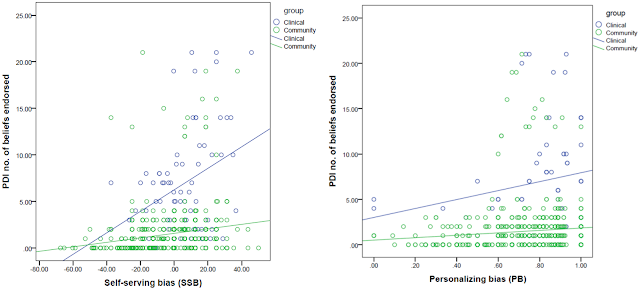This study compared
delusional dimensions and attribution biases along the continuum of psychosis.
Participants completed questionnaires on delusion-like beliefs and
attributions. Although patients with first-episode psychosis (N = 70) endorsed fewer delusion-like beliefs than
non-clinical individuals with psychotic-like experiences (N = 12), they scored highest on delusional conviction,
distress and preoccupation, followed by non-clinical individuals with
psychotic-like experiences, and then healthy controls (N = 642). Self-serving bias was found in patients and
non-clinical individuals with psychotic-like experiences, but not in healthy
controls. Personalizing bias for negative events was not significantly
different across the three groups. When compared with healthy controls,
non-clinical individuals with psychotic-like experiences had an exaggerated
self-serving bias, but were not more marked in personalizing bias. Self-serving
bias and personalizing bias were both associated with delusional dimensions.
However, the association between self-serving bias and number of delusion-like
beliefs was stronger among patients than non-clinical participants. Future
research could investigate the extent to which self-serving bias, in
combination with an appraisal of delusional ideation as convincing, distress,
and preoccupying, contributes to the development of clinical delusions.
Below: Association between attributional biases and number of delusional ideations.
Below: Association between attributional biases and level of delusional conviction
Full article at:
By:
Suzanne Ho-wai So, Patrick Wing-leung Leung
Department of Psychology, The Chinese University of Hong
Kong, New Territories, Hong Kong Special Administrative Region, China
Venus Tang
Department of Clinical Psychology, Prince of Wales Hospital,
Shatin, Hong Kong Special Administrative Region, China
More at: https://twitter.com/hiv_insight


No comments:
Post a Comment